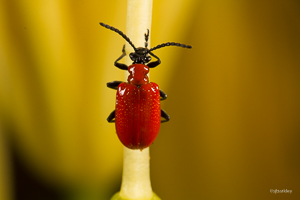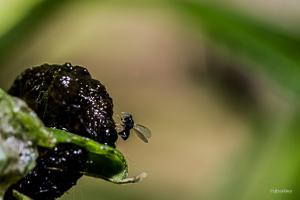
The lily leaf beetle (Lilioceris lilii) is a native of Europe and was originally found in Canada at Montreal in 1945. Since then, it has spread throughout Eastern Canada and has now established itself as far west as Alberta. Long distance movement of the beetle is facilitated by movement of plant material; locally, they move on their own as they are strong flyers.
The lily leaf beetle lays its eggs and develops only on true lilies (Tiger, Easter, Asiatic and Oriental lilies) and fritillaries. They can feed (but not develop) on other perennials like lily-of-the-valley. Adult and larval feeding will ruin true lilies. The feeding damage can be so severe that many gardeners have removed lilies from their landscapes.
The adult beetle overwinters in the soil or leaf litter, not necessarily near host plants. They emerge on the first warm spring days and will begin feeding on the early emerging lilies, as early as mid-April on the Prairies. Shortly after emergence, they start to mate and lay orange eggs in rows of 3-12 on the undersides of the lily leaves or on the emerging lily shoots (late April to early May). Egg laying (up to 450 per female) can continue well into July. Eggs will hatch in 4-8 days.
The larva is a soft, hump-backed, orange to brownish slug-like animal with a black head and legs. For protection from predation, desiccation and camouflage, it covers its body with a layer of its own fecal matter. The larval stage most destructive phase of the beetle’s life cycle, as larvae feed for 16-24 days. They devour leaves leaving only the plant stems, and chew into flower buds. Larvae drop to ground to pupate and emerge as adults 16-22 days later.
Tetrastichus setifer, a small parasitoid wasp (harmless to humans), is being introduced as biological control agent for the beetle. T. setifer overwinters in the soil in a cocoon. It then emerges in the spring and the female will lay up to nine eggs in one lily leaf beetle larva. She can lay eggs in all four larval instars of the lily leaf beetle.
There have been successful T. setifer releases in Ottawa with establishment and good suppression of lily leaf beetles. Releases have been done in gardens in Manitoba and Quebec as well natural sites in Quebec where the native lilies Lilium canadense, and Lilium michiganense grow. Successful establishment of T. setifer in the natural locations is uncertain at this time. Recently, there have been releases in Calgary, Alberta and Olds, Alberta. In 2018 additional releases were made in 2 gardens in Brooks, Alberta.

For information about previous featured insects, please visit our Insect of the Week page. For even more information on crop pests and their natural enemies, be sure to check out our newly updated Field Guide and Cutworm Guide, available for free download on our Insect Field Guide and Cutworm Field Guide pages.
